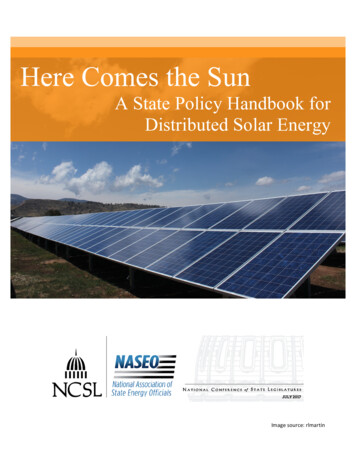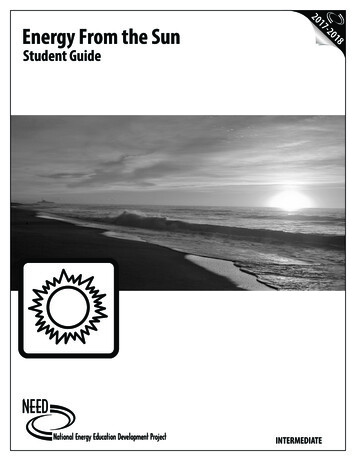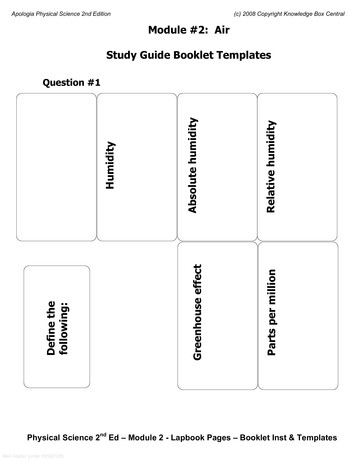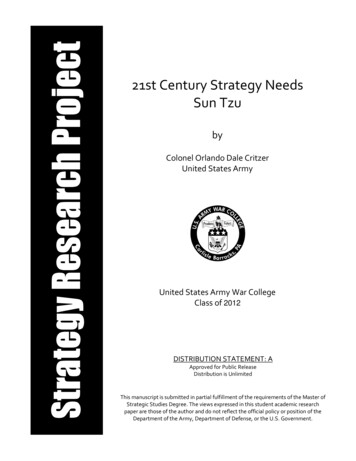
Transcription
Here Comes the SunA State Policy Handbook forDistributed Solar EnergyImage source: rlmartin
AcknowledgementsNCSL would like to thank the following entities for their contributions to this report. Sections in thisreport relied heavily on,“Standards and Requirements for Solar Equipment, Installation, and Licensing and Certification,” byBeren Argetsinger and Ben Inskeepfor the Clean Energy States Alliance. The Database of State Incentives for Renewables and Efficiency(DSIRE) maintained by theNorth Carolina Clean Energy Technology Center also informed a significant amount of content.Finally, NCSL and NASEO would like to thank staff from the following organizations for providingcomments on this handbook or its initial outline: the U.S. Department of Energy,the Clean Energy States Alliance, the Interstate Renewable Energy Council, the Lawrence BerkeleyNational Laboratory,the National Renewable Energy Laboratory, the North Carolina Clean Energy Technology Center, theRegulatory Assistance Projectand the Solar Foundation, as well as Kansas Representative Tom Sloan.NATIONAL CONFERENCE OF STATE LEGISLATURESii
Here Comes the Sun:A State Policy Handbook forDistributed Solar EnergyNational Association of State Energy Officials (NASEO)Stephen GossFred HooverNational Conference of State Legislatures (NCSL)Glen AndersenMegan ClevelandJocelyn DurkayAbout NCSL and NASEOn NATIONAL CONFERENCE OF STATE LEGISLATURES (NCSL)The National Conference of State Legislatures is the bipartisan organization that serves the legislatorsand staff of the states, commonwealths and territories. NCSL works to build and maintain strong andindependent states by providing them with the tools, information and resources needed to craft thebest solutions to difficult problems. NCSL provides research across a wide variety of topics rangingfrom energy to education to health to fiscal policy to civil and criminal justice. NCSL is committed to thesuccess of all legislators and staff and serves to: Improve the quality and effectiveness of state legislatures. Promote policy innovation and communication among state legislatures. Ensure state legislature have a strong, cohesive voice in the federal system.n NCSL’S ENERGY PROGRAMNCSL’s Energy Program provides policymakers and staff with state-by-state analysis of energy issues,technical assistance, and works to help legislators in their efforts to maintain a reliable and cost-effective energy system that promotes economic development in their states. The topics covered by theEnergy Program include climate and energy, energy efficiency, energy infrastructure and reliability, fossilfuels, nuclear energy, renewable energy, transportation energy and tribal energy.Visit http://www.ncsl.org/research/energy.aspx, for Energy Program newsletters, publications andlegislative updates, legislative tracking tools and meeting resources.n NATIONAL ASSOCIATION OF STATE ENERGY OFFICIALS (NASEO)The National Association of State Energy Officials (NASEO) is the only national non-profit associationfor the governor-designated energy officials from each of the 56 states and territories. Formed by thestates in 1986, NASEO facilitates peer learning among state energy officials, serves as a resource for andabout their offices and communicates the states’ views to Congress, federal agencies and the privatesector.State energy officials advise and inform governors and state legislators on energy issues and ensurethat the needs and issues of industry, business and residential energy consumers are considered duringenergy policy, program and regulatory development. They are responsible for planning and respondingto energy emergencies resulting from all hazards, including weather and cyber events and assistingin the recovery of energy systems with energy providers. State energy officials also provide educationand information to the public and businesses on energy practices and technologies that aid in reducingenergy waste, advance economic development, support environmental quality and enhance energysecurity.Visit http://naseo.org/ for energy planning guidelines, publications and meeting resources.iiiNATIONAL CONFERENCE OF STATE LEGISLATURES
ContentsGlossary . ixExecutive Summary.1Introduction .3Incorporating Solar into State Energy Planning Guidelines.7State Policy Options .9Compensating Solar Energy Producers.9Net Metering .9Policy Variations.10Net Metering System Types .11Aggregate Net Metering .11Shared Renewable Energy .11Emerging Compensation Methods .13California’s Successor Tariff .14Hawaii’s Grid-Supply and Self-Supply.14Location-Based Valuation .14Tariffs .15Feed-in Tariffs.15Value of Solar Methodology .17Hawaii’s Community-Based Renewable Energy Tariff .17Rate Design and Solar .18Policy Considerations .19Performance-Based Regulation .20Increasing Fixed Charges .20Demand Charges .21Time-Based Rates and Dynamic Pricing.22Solar Incentives and Market Building Policies .23
Ownership Models.28Utility Ownership .28Third Party Ownership .29Customer-Owned.32Renewable Energy Credit Ownership .33Financing.34Loan Programs.34Property Assessed Clean Energy .34State Energy Loan Funds .36On-Bill Financing .36Qualified Energy Conservation Bonds.39State Green Banks .39Consumer Protection.40Low- and Moderate-Income Customer Access .42Financing Approaches .42Funding Approaches .43Shared Renewable Energy Programs .43Solar Integration.44Grid Operation .45State Action .48PV System Soft Costs.50Building Policies and Codes .52Fire Codes.53Electrical Codes .54Solar Training and Certification .55Solar Access and Rights.57Solar Photovoltaic Panel Recycling and Decommissioning.58Appendix: Resource List.60Notes .65vNATIONAL CONFERENCE OF STATE LEGISLATURES
GlossaryAggregate Net Energy Metering: expands conventional netmetering allowing a single customer to offset electrical use frommultiple meters on his or her property, using a single renewableenergy generating system also located on the owner’s property.energy from independent power producers if the cost is equal toor below the cost of the utility for producing the energy itself. TheFederal Energy Regulatory Commission has jurisdiction over PURPAmatters.Business Energy Investment Tax Credit (ITC): the 30 percentfederal tax credit for solar systems on residential and commercialproperties. Extended through 2019 at present value, with a gradualreduction in value over the following two years.PV: solar photovoltaic technology, the fastest growing form of solarenergy generation.Renewable Energy Certificates (RECs): also known as renewableenergy credits, represent the environmental attributes of electricitygenerated through a qualifying renewable energy resource. OneREC is issued for every one megawatt-hour (MWh) of electricityproduced by the qualifying source.Database of State Incentives for Renewables and Efficiency(DSIRE): a database operated by the North Carolina Clean EnergyTechnology Center that provides federal, state, local and utilitypolicy and program data.Renewable Portfolio Standard (RPS): also known as a RenewableEnergy Standard (RES), requires utility companies and otherelectricity suppliers to source a certain amount of the energy theysell from designated renewable and clean energy sources.Demand Response (DR): a coordinated process of reducingelectricity consumption to relieve stress on the grid during peakhours or power outages. DR is also useful for integrating variablegeneration sources, such as wind and solar.Retail Energy Pricing: also known as the retail rate, a rate ofcompensation for electricity sold from electricity suppliers to utilitycustomers.Distributed Energy Resources (DER): smaller power resourcesthat are located close to where electricity is used. May be ownedby customers and located on the customer side of the electricmeter. Examples of DER include distributed generation and energystorage.Shared Renewable Energy (Shared Renewables): also known asor includes community renewables and community solar gardens.Shared renewable energy is a renewable energy system where theelectricity generated directly benefits multiple customers.Generation (DG): power generation at the point of consumption,on the distribution grid. Rooftop solar is an example of DG.Solar Renewable Energy Certificates (SRECs): also known as solarrenewable energy credits, a representation of the environmentalattributes of electricity generated through solar energy.Distribution Grid: the portion of the electric grid that is locatedbetween the transmission grid substations and individual houses orbusinesses.Third Party Ownership: refers to the financing mechanism forresidential or commercial renewable energy installations wherethe entity that consumes the electricity generated is different thanthe system owner. With rooftop solar, for example, a homeownercan host a renewable energy system that is owned by anotherentity. Third party ownership agreements take the form of leases orpower purchase agreements.Federal Energy Regulatory Commission (FERC): the federal entityresponsible for monitoring interstate energy markets, regulatinginterstate transmission and wholesale electricity prices.Gigawatt (GW): equal to 1,000 kilowatts. The average homeconsumes about 1.2 kilowatts of electricity on average.Kilowatt-hour (kWh): one kWh of energy is 1,000 Watts (1 kW) ofpower delivered for one hour. A microwave or toaster consumes inthe range of 1,000 Watts.Time-of-Use Pricing (TOU): an approach to electricity ratemakingwhere prices vary based on the time of day.Value of Solar Tariff (VoS/VOST): a payment offered to solarelectricity generators based on the value of solar generation to theelectric grid. Value components may include avoided fuel value,avoided generation capacity value, transmission and distributioncosts, environmental costs, and others.Net Energy Metering (NEM): a billing mechanism that credits DGowners at the retail rate for selling excess electricity to the grid.Power Purchase Agreement (PPA): a financial agreement wherea developer installs a renewable energy system on a customer’sproperty at little or up-front no cost to the customer. The developermaintains ownership of the system and sells the power generatedto the host customer at a fixed rate. PPAs also refer to long-termpower purchase contracts between utilities and owners of powergeneration.Virtual Net Energy Metering: a form of net energy meteringthat allows multiple customers to offset their energy use froma common distributed generation system. Virtual net meteringcan serve as a compensation mechanism for shared renewablessystems.Public Utility Regulatory Policies Act (PURPA): a 1978Congressional Act spawned by the energy crisis that was designedto encourage domestically produced energy from renewables andcombined heat and power. PURPA requires utilities to purchaseWholesale Pricing: also known as the wholesale rate, a rate ofcompensation for electricity sold from electric generators tosuppliers.viiNATIONAL CONFERENCE OF STATE LEGISLATURES
Executive SummaryThe rapidly transforming energy sector presents a host of opportunities, such as increased resilience,cleaner energy technologies, a more efficient and reliable energy system, as well as greater flexibility,choice and control for consumers. One of the newer sector technologies that is driving this transformation is distributed generation, with distributed solar energy leading the way.States have played a significant role in this energy revolution by creating policies, incentives and regulations that have transformed the solar and power markets. These efforts have been motivated by arange of factors, including economic development, job creation, improved air quality, sustainability goals,economic development, energy diversification and resilience to name a few.Generating power on-site and close to where it is consumed has evolved over the past 20 years, requiringstates to explore new regulatory and policy approaches. Most states’ electricity regulatory frameworkswere designed with large centrally-owned and operated power stations in mind. Adapting the grid andits supporting policies to accommodate consumers’ decisions to generate and use their own power,while sending some power onto the distribution grid, may require significant changes in regulatory andoperational approaches. The technical challenges of integrating consumer-produced power are beingovercome by most utilities, however, policy and operational approaches can lessen the challenge, lowercosts and increase reliability as distributed power gains market share.This handbook is designed for state legislators, legislative staff, energy officials and others who want tolearn about and assess their state’s distributed solar photovoltaic policies. It provides them with the toolsto investigate options and practices to leverage the economic and reliability benefits of solar energy whileaddressing the challenges presented by this localized approach to energy generation. This documentcovers the many options and innovative approaches that states have implemented or considered whenit comes to rate design, incentives, integration, financing, regulation and workforce development. Whileextensive, this report is by no means comprehensive, and provides readers with several references andresources for a deeper exploration of the topics covered.This document will assist policymakers and planners that wish to tailor their state’s energy policy to bestleverage the opportunities offered by the burgeoning of distributed solar energy.1NATIONAL CONFERENCE OF STATE LEGISLATURES
U.S. PV Installations, 2000-2016Source: SEIA/GTM Research U.S. Solar Market InsightIntroductionSolar electricity production is on the rise. Installations are soaring, costs are declining and the industry isgrowing. This rapid growth has generated greater interest in the solar energy sector, as well as questionsabout how to craft solar policy in the face of these changes. State legislators and energy officials areactively working to address the rapid rise of solar in a way that reflects their state’s goals and markets.This report provides state legislators, energy offices, governors and commissioners, as well as otherinterested parties the tools to understand the distributed solar market in their states, assess their state’spolicies and regulations, and determine a path forward.THE GROWTH OF SOLAR ENERGYSolar energy has experienced explosive growth in recent years. In the 2016 year alone, the U.S. solarmarket nearly doubled its annual record for installations—with 14,800 MW of new solar PV installed, a97 percent increase over 2015, which itself had broken the previous year’s record.1In another milestone, solar energy represented 39 percent of new capacity additions for all fuel types in2016, outpacing natural gas for the second consecutive year.2 In total, 42.4 GW of solar capacity has beeninstalled in the U.S. as of the end of 2016, producing enough energy to power 8.3 million homes. TheSolar Energy Industries Association (SEIA) predicts this amount will triple in the next five years as growthcontinues.3Solar energy comprises just over 1 percent of total generation in the U.S., however, and is likely to bebelow 3 percent for the next five years. 4 Some states will see stronger growth in that timeframe however,with California, Hawaii, Nevada and Vermont each projected to surpass 20 percent of generation fromsolar.5Recent innovations in solar PV technology have dramatically lowered the cost of solar energy while increasing the value proposition. The levelized cost (defined as lifetime costs divided by energy production,allowing for the comparison of various technologies across different lifespans6) of utility-scale solar PV hasdecreased 74 percent, while the levelized cost of residential solar PV has decreased 57 percent between2010 and 2016.7 Additionally, the efficiency ratings on PV modules continue to improve.8During the first quarter of 2017, the average total cost for a typical 6-kilowatt residential rooftop PVsystem was roughly 17,000, before applying the 30 percent federal tax credit.9 The installed costs varywidely, however, driven mostly by differences in “soft” costs. Soft costs include: installation, permittingand interconnection fees, labor, taxes, transaction costs and indirect expenses (see “PV System Soft3NATIONAL CONFERENCE OF STATE LEGISLATURES
U.S. Capacity Additions, 2016In gigawatts (1 gigawatt 1 billion watts)Natural Gas 8Hydro 0.3Solar 16Nuclear 1.1Petroleum/Other 0.3Wind 6.8Note: Solar capacity additions include both utility scale and distributed solar.Source: Solar Electric Power Monthly, GTM ResearchCosts” in State Policy Options, page 50). One Department of Energy (DOE) analysis found that non-hardware costs account for as much as 64 percent of the cost of new solar systems.10 Soft costs vary dramatically across localities and states, in part due to a patchwork of regulations across 18,000 localitiesand 3,000 utilities.11 Some states are developing policies to decrease these costs to make it easier andcheaper for ratepayers to access solar energy. For example, California passed Assembly Bill 2188 in 2014that required all city and county governments to adopt an expedited, streamlined permitting process forsmall residential rooftop solar energy systems.SOLAR TECHNOLOGYSolar energy technology can be divided into several categories: photovoltaic (PV), heating and cooling,and concentrating solar power (CSP). This handbook largely focuses on solar PV technology and policies.Solar PV is scalable and can be installed on roofs or other surfaces, or be mounted on the ground. Thistechnology uses the photoelectric effect, with photons from the sun hitting the semiconductor in a PVpanel, dislodging electrons, which then flow in a single direction and generate a direct current. PV systems need an inverter to change the direct current (DC) produced by the solar panels into the alternatingcurrent (AC) used by the grid.Concentrating solar power is a large-scale solar application where mirrors concentrate thermal (light) energy to drive traditional steam turbines or engines, generating electricity. Thermal energy in a CSP plantcan be stored or used directly, allowing for continuous power generation. Arizona, California and Nevadahave CSP plants.12 The falling price of PV has made CSP a less competitive option.NATIONAL CONFERENCE OF STATE LEGISLATURES4
How DoesPV Technology Work?Photons strike and ionizesemiconductor material onthe solar panel, causing outerelectrons to break free oftheir atomic bonds. Due to thesemiconductor structure, theelectrons are forced in onedirection creating a flow ofelectrical current.Source: Solar Energy Industries Association(SEIA); Illustration by Kurt StuveTypes of TechnologyPhotovoltaic (PV)This directly produces electricity whichcan be used, stored, or converted forlong-distance transmission.Concentrating Solar Power (CSP)Using reflective materials like mirrors andlenses, these systems concentrate sunlightto generate thermal energy, which is inturn used to generate electricity.Solar Heating Cooling (SHC)SHC generates thermal (heat) energy forwater and pool heating and space heating/cooling.Solar heating and cooling, also known as solar thermal, uses the sun’s thermal energy to heat water or air.Common applications are water heating, space heating and cooling, and pool heating in the residential,commercial or industrial sectors.ECONOMIC DEVELOPMENTEconomic development is one major reason states are seeking to grow the solar market, with the aim of driving new job and industry growth. There are now more than 650 domestic manufacturing facilities in 28 states.These jobs serve local economies, generate local tax revenue and contribute to the national solar market.Employment in the solar energy sector exceeded 260,000 positions in 2016—a threefold increase since2010 and one of every 50 new jobs added in 2016 was in the solar industry. 13 According to U.S. Departmentof Energy, solar industry employment jumped by over 73,000 jobs, or 25 percent, in 2016. Solar energyindustry employment growth in 2016 outpaced the nation’s overall economic growth by 17 times. Approximately half of these solar jobs were in installation with an average hourly salary of 26, followed bymanufacturing, sales and distribution, and project development.14 Nearly 70 percent of jobs identified donot require a Bachelor’s degree and veterans are employed in the industry at a rate higher than the nationalaverage.STATE, LOCAL AND FEDERAL ROLESSolar energy is governed by state, local and federal policies. States are the leaders in driving solar energy policy decisions, as there is no unified national energy strategy. Legislatures, governors and energy offices enact5NATIONAL CONFERENCE OF STATE LEGISLATURESSource: SEIA
policies that shape the viability of solar energy and its deployment. State legislatures have the authorityto enable new policies, convene stakeholders, mandate certain approaches and study innovative strategies. As appropriators of the state budget, legislatures can fund new programs, initiatives or incentives.They are also the institutions that may address unintended policy consequences or market barriers. Statelegislatures decide whether to empower state agencies—including state energy offices or public utilitycommissions—to pursue specific policy approaches.State energy offices serve as implementers of policies, fulfilling legislative directives and acting on thegovernor’s policy decisions. Many state energy offices oversee programs that provide financial incentivesfor solar deployment through grants, loans and tax credits. In many states, energy offices work withlocal governments and utilities to reduce soft costs of solar development through expedited permittingand interconnection. State energy offices have also advocated for broader solar access for low-incomecustomers through community solar programs.These state institutions are dependent on the policy environment. For example, if state legislationcreates a solar carve-out in a Renewable Portfolio Standard, state public utility commissions must createregulations to ensure compliance. Additionally, if a legislature creates incentives—such as tax credits orgrants—to support solar deployment, it frequently directs the state energy office to develop regulationsor programs to administer these incentives.At the federal level, Congress is responsible for authorizing incentives, including the Business EnergyInvestment Tax Credit (ITC). The ITC—which was reauthorized in 2015 for solar PV, solar water heating,solar space heating and cooling, and solar process heat—provides a 30 percent tax credit to systems thatbegin construction before 2020. The credit decreases to 10 percent beginning in 2022.15 Congress reauthorized the Residential Renewable Energy Tax Credit at the same time. This credit provides a 30 percenttax credit to solar PV and solar water heating systems placed in service by the end of 2019. The credit hastwo declining levels before expiring for systems installed after 2021.16Another federal entity, the Federal Energy Regulatory Commission (FERC), regulates interstate transmission and wholesale electricity prices in addition to monitoring energy markets.17 FERC also has oversightof long-term contracts for third-party-operated renewable energy resources under the federal PublicUtility Regulatory Policies Act (see “Ownership Models” in State Policy Options, page 28).Localities can supplement state and federal policies,
compensa on for electricity sold from electricity suppliers to u lity customers. Shared Renewable Energy (Shared Renewables): also known as or includes community renewables and community solar gardens. Shared renewable energy is a renewable energy system where the electricit










